An efficient shortest path approach for social networks based on community structure☆
2016-04-11MoguoGongGunjunLiZhoWngLijiMDyongTin
Moguo Gong*,Gunjun LiZho WngLiji MDyong Tin
aKey Laboratory of Intelligent Perception and Image Understanding of Ministry of Education,International Research Center for Intelligent Perception and Computation,Xidian University,Xi'an 710071,China
bCenter for Quantum Computation and Intelligent Systems,University of Technology,Sydney,Broadway,NSW 2007,Australia
Original article
An efficient shortest path approach for social networks based on community structure☆
Maoguo Gonga,*,Guanjun Lia,Zhao Wanga,Lijia Maa,Dayong Tianb
aKey Laboratory of Intelligent Perception and Image Understanding of Ministry of Education,International Research Center for Intelligent Perception and Computation,Xidian University,Xi'an 710071,China
bCenter for Quantum Computation and Intelligent Systems,University of Technology,Sydney,Broadway,NSW 2007,Australia
Finding the shortest path(SP)in a large-scale network analysis between any two nodes is a tough but very signi ficant task.The SP can help us to analyze the information spreading performance and research the latent relationship in the weighted social network,and so on.As the size of the social network increases,the traditional SP algorithms have poor performance and there is not a suitable algorithm for weighted social network.Some features of the network analysis are bene ficial to solve this problem,and community structure ignored by the traditional methods is one of the most important features.In this paper,we propose a shortest path algorithm based on community detection(SPCD)by integrating community detection algorithm with traditional search methods.SPCD constructs a community graph by using community structure to narrow the searching scope.The algorithm presented improves the time ef ficiency and maintains the accuracy scale of the SP.Experimental results on five real-world networks demonstrate the effectiveness of the proposed methods for the SP problem.
Shortest path;Community structure;Weighted social network
1.Introduction
Recently,studies on social network have attracted a lot of attention from sociology,informatics and computer science [1,2].A social network is a social structure made up of a set of social actors(such as individuals or organizations)and a set of the dyadic ties between these actors.A huge amount of data and resources make it critical to analyze social network related problems.A series of research on social network have been done in many aspects of sociology,such as social influence, socialgroupings,inequality,diseasepropagationand communication of information[3].The SP problem which calculates the distance or relationship between the nodes in the social network is an extremely important problem of social network analysis.It can be used to study the behavior of information spreading,especially fastest information spreading. The recommendation system is also based on the SP problem. For example,when we analyze the relationship between scientists,the scientists collaboration network is established and analyzed utilizing the SP problem.Analyzing the scientist collaboration network,the work and paper reviewing eff iciency can be improved.The SP problem serves as an elementary aspect when analyze the network structure,for example betweenness and average distance.With the increase of network scale,the previous algorithms may not suitable for the existing network,so we need effective methods for largescale network.In this paper,we focus on the SP problem between any two nodes in the weighted social network.The SP problem concerns with finding the shortest path from aspecific origin to a specified destination in a given network while minimizing the total cost associated with the path.SP is a fundamental problem in social network.In a graph,finding the path with the minimum cost from a source nodesto a destination nodedis called the point-to-point(P2P)problem, but a common variant fixes a single node as the source node and finds shortest paths from the source to all other nodes in the graph.In addition to P2P problem,other shortest path problem,such as single-destination,all-pairs and so on,could be converted to single-source shortest path.The single-source problem with non-negative arc lengths has been studied most extensively[4].For a general network,traditional dijkstra's algorithm could be used for solving all the non-negative, weighted or non-weighted networks without any domainspecific information.Though it is a single-source algorithm, we can transform it to a P2P algorithm by terminating at destination node.But it has high time complexity ofO(n2),so it might not work well on the SP in social network,especially in large-scale social network.The time complexity of modified standard breadth-first isO(n),but it is suited to non-weighted network[5].With the increase of network scale,authors used domain-specific information about the network to deal with it. In traffic networks,researchers have adopted the natural hierarchies to speed up a shortest path algorithm significantly [6-10],and more algorithm are given in[11].It is obvious that these algorithms could not be applied to social network. From the same point of view in traffic networks,the feature of social network can be utilized to the SP problem.Community feature is one of the most important characteristics of social network.
In recent years,community detection has gained a lot of attention in the field of network analysis.Community structure is similar to the small world effect and the right-skewed degree distributions which are an important distinctive property in a complex network[12].Qualitatively,a community is defined as a subset of a graph in which the interconnections of nodes are denser than those observed with the rest of the network [13,14].For the general case of a weighted graph,many approaches mainly focused on various criteria including modularity[15],structural density[16]and partition density[17]. Blondel et al.introduced a fast greedy approach(BGLL)to optimize the modularity[18].Besides,parameter-free hierarchical network clustering algorithm(SHRINK)proposed by Huang et al.combines the advantages of density-based clustering and modularity optimization methods[19].In the field of social networks,Xie et al.proposed a general speakerlistener algorithm named SLPA based on label propagation [2].Evolutionary computation is also an important and influential method[20,20,21].Community detection clusters the edges into two classes:the shorter ones and the longer ones.In that case,we can pay our attention to the large edges and find out the communities including the SP,and then searching the SP in these communities.As far as we know,there is no method using community information to solve P2P problem in weighted social network.In this paper,we propose a new shortestpathalgorithmbasedoncommunitydetection (SPCD).Using community information,SPCD can narrow down the search space and decrease computing time for a path while sacri ficing accuracy within a certain level.It can strike a balance between accuracy and time ef ficiency while being faced with different problems.
The paper is organized as follows.Section2 describes the proposed SPCD algorithm in detail.Section3 is experiment in five datasets.This subsection analyses accuracy and ef ficiency. Moreover the in fluence of community path number and community detection method to SPCD is discussed.We conclude the paper is Section4 and point out the future work.
2.Algorithm description
In this section,the proposed algorithm is described in detail.First,the community definition and detection is introduced,and then the method of constructing community graph is described.Thekshortest community paths are given in subsection2.3.Finally,the shortest path in sub-graph is given.
2.1.Community definition and detection
Adopted symbols are listed in Table 1.Communities are groups of vertices which share common properties and/or play similar roles within the graph.Qualitatively,connections between the nodes in a community are denser and closer than connections with the rest of the network.For SP in weighted social network,we define the community in such a way that the connections in the community have a lower cost but connections between the communities have higher cost.In this paper,we use distance to measure the relationship of any two nodes in the network.The smaller the distance,the more highly related the any two nodes.Thus the target of the SP problem is to find the minimal distance between any two nodes in the network.As for the other applications which need to find the maximum the distance,they can be easily transformed into this minimization problem by reverting the evaluation function.
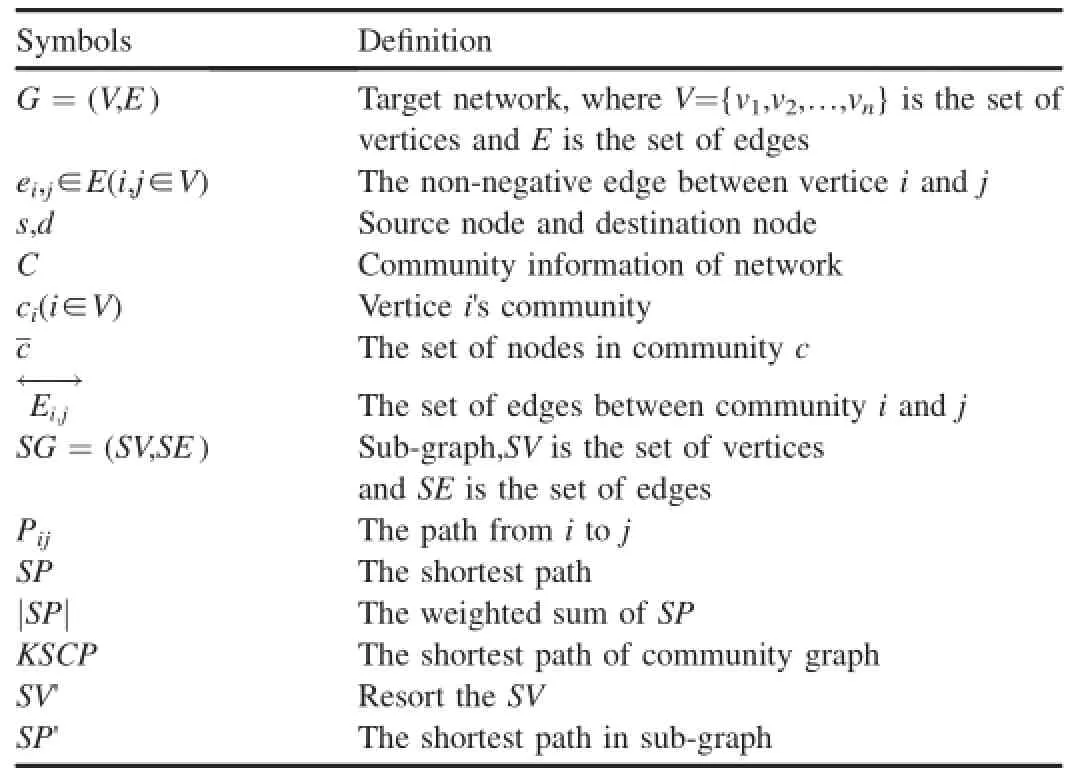
Table 1 Notation.
A demonstration of community in a network is shown in Fig.1.The weight of edge betweenjandlis 20,which ismuch bigger than 0.2,the weight of edge betweeniandj,i.e.eij≪ejl.So according to our definition of community,nodesiandjare clustered into the same community(ci=cj)whilelis clustered to another community(cj≠cl).

Fig.1.Community detection by our definition.
Xie J.et al.[2]suggest a general framework that uses Speaker-listener Label Propagation Algorithm(SLPA)to detect communities and it clusters the bigger edges into a community for weighted network.In this case,we cannot use Xie's method directly.We reverse the target network before performing SLPA.The reversal network is obtained as follows.First, find the maximum value of the weights of the edges,namely the maximum edge cost,denoted bymaxe. Second,generate a positive value 1 or any other positive value and added withmaxe,denoted bymaxe',i.e.maxe'=maxe+1. Creating a positive value is to prevent the maximum edge from becoming zero in the next step.Then the cost of the edges in the reversal network aremaxe'minus the original corresponding non-negative cost.The cost of edges remains the same if the cost is zero and we can get the reversal network(A example in Fig.2).Through the above steps,the bigger edge in the original network is reversed to the smaller edge in the reversal network,so that the community information that comes from performing the Xie's method on the reversal network is the community information that suits our community de finition.
2.2.Constructing community graph
We construct the community graph to make full use of the network community information.According to our de finition of community,these edges between communities have bigger cost,so we can use the edges between communities to represent these paths.In Fig.3,we knoweijis bigger thanesiandejd,in other word,eij≈esd,soPijcan be used to replacePsdand we can focus on the edges between community when searching the shortest path from nodesto noded.
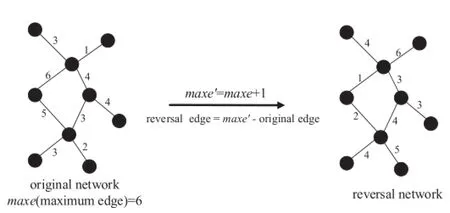
Fig.2.Transforming network into the reversal network.
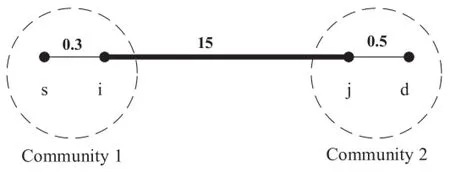
Fig.3.Edge between communities can replace the path.
According to the above analysis,we can build the community graphCG=(CV,CE)based on the result of community detection,where each vertices inCVrepresents a community of the original network and edgesCEare the minimum cost between each two communitiesCompared with the edges between communities,the cost of edges in the community is smaller and ignored temporarily,so we treat all the nodes in the community as one node,that is to say,the community these nodes located is the node of community graph.There might be more than one edge between communities and we choose the minimum cost edge as the connectionofcommunity graphbetween corresponding community nodes.The aim of SP problem is searching the smallest path,so we select the minimum cost edge in this step. After that we model the original network to a new weighted community graph.
See an example in Fig.4.The original network is clustered into three communities,so the community graph has three nodesCV={cv1,cv2,cv3}.Edgece1,2in community graph is equivalent to the minimum cost edge between community 1 and 2miIn a similar way we get edgesce1,3=3.3 andce2,3=8.0.
2.3.K shortest community paths

Fig.4.Building community graph.
So as to find the SP in the original network,the shortest community path includes the SP should be found primarily.There is a situation that the SP is not included in the shortest community path but in the second shortest ork-th shortest community path,so the next step is calculate thekshortest community paths.Kshortest paths problem means finding the topkpaths from source node to destination node in order of increasing cost.If the number of paths from source community to destination community is less thankin our community graph,all the paths are selected.

Fig.5.k shortest path in the community graph.
Original network was modeled to community graph by our method.The real shortest path in the original network is included in the community graph.Moreover,there is a high probability that the actual shortest path can be found in the shortest community path.However,we cannot ignore the situation that the real shortest path is not concluded in the shortest community path,but in another path among thekshortest community paths.Based on the above analysis,we calculate thekshortest community pathsWe use Yen's algorithm[22]to find the exactSPkfrom the source communitycsto the destination communitycd(See example in Fig.5).When the number of paths fromstodin the graph is less thank,we take all the existing paths as theSPk.Ifsanddare in the same community,the shortest community path is the community,and thekshortest community paths are the community with its neighbor communities.Intuitively,the scale of community graph is far smaller than that of the original graph,so theSPkcan be obtained efficiently.
2.4.The shortest path in sub-graph
Weutilizethekshortestcommunitypathsto establishthesearchsub-graph.Theremaybetwo community paths intersect,e.g.sp1=(c1,c2,c3,c4,c5,c6)andsp2=(c11,c32,c3,c4,c5,c19)have same communities(c3,c4,c5), so we get the search communitiesC'=c1,c2,…,cnby
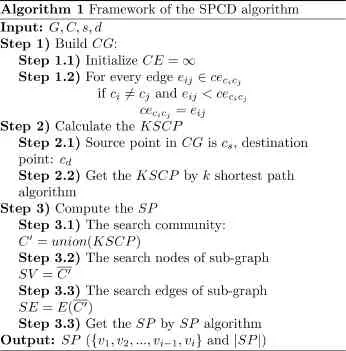

Fig.6.Decrease the scale of graph by our method.
striving for the intersection of thekshortest community paths. Next we get the nodes of sub-graphSV={c1,c2,…,cn},and sort fromSVtoSV'.For example,we obtain a set of sub-nodeSV=5,3,8,22,66,…,88 that from the original graph and sorts it asSV'=1,2,3,…,n.SEis equal to the cost between thecorresponding nodes in the original graph,e.g.se1,2=e5,3that sub-node 1 is sorted from the original graph node 5 and 2 from 3.The following step is calculating the SP'by SP algorithm in the sub-graph,but the node in SP'we get is fromSV',so we need to get the original SP from the SP'according to the sorting.IfSP'=1,3,…,n,the SP we wanted is 5,8,…,88.The cost of the path|SP|=|SP'|.From above we know that theSVis a part ofV,in other words,sub-graph is much smaller than the original network,so we can find the SP with less time.
Our algorithm utilizes community information to build a community network and find the community paths,then extracting sub-graph from the original network.Finally, obtaining the SP from the sub-graph.This community path can help us narrow down the search space size,so the searching time is saved(see a example in Fig.6).A high precision requires a largerk,but the largerkleading to increase the time complexity,so we must set a properk.The pseudo-codes for general algorithmic flow of this algorithm are listed in Algorithm.1.

?
3.Experiment and analysis
Our algorithm SPCD is implemented in Matlab 2012a.All the experiments were run on a Windows 7 server with 2 2.00 GHz Intel(R)Xeon(R)CPU E5-2620 and 64 GB of memory.
3.1.Datasets
We ran experiments in five collaboration networks in which the nodes mean scientists and a link between two scientists is established by their coauthorship of one or more scienti fic papers.Collaboration network has a more promising source of data and this network is in some ways more truly a social network than many other networks[3].
(1)Coauthorships in network science:coauthorship network of scientists(net-science)working on network theory and experiment including publications up until early 2006,as compiled by M.Newman in May 2006[23].The network has a total of 1589 scientists in it,from a broad variety of fields[23].
(2)High-energy theory(hep-th)collaborations:weighted network of coauthorships between scientists posting preprints on the High-Energy Theory E-Print Archive[3] between Jan 1,1995 and December 31,1999[24].The network contains 8361 nodes and 15751 edges.
(3)Astrophysics collaborations(astro-ph):weighted network of coauthorships between scientists posting preprints on the Astrophysics E-Print Archive[25]between Jan 1, 1995 and December 31,1999[24].The network contains 16706 nodes and 121251 edges.
(4)Condensedmattercollaborations1999(con-mat): weighted network of coauthorships between scientists posting preprints on the Condensed Matter E-Print Archive[26]between Jan 1,1995 and December 31,1999 [24].The network contains 16726 nodes and 47594 edges.
(5)Datasets of nuclear experiment(nucl-ex):published in Los Alamos e-Print Archive[27]from December 1994 to the present.We construct the network of every year from 1994 to 2014 and make some statistics.The authors(i.e. vertices)that identify each author by his or her surname and first initial only[3]and weight[5]are defined by M. Newman.

?
The scale of these collections is listed in Tables 2 and 6.
3.2.Performance evaluation
We evaluate the accuracy of the proposed algorithm in the search process for the SP between nodes.We choose 500 existing pairs of nodes randomly and run 10 times independently for each dataset to get average accuracy.The approximation erroraperis:
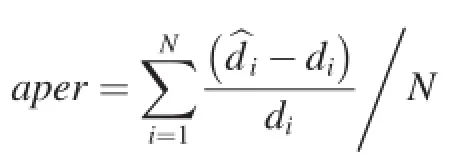
wherediis the actual distance for i-th pair of nodes andˆdiis the approximation value.The actual distance was measured by dijkstra's algorithm[28]with time complexityO(n2).It can be optimized toby a Fibonacci heap [29].We must guarantee a minimumaperthat is different in some cases.Set the minimumaper=0.05 for all the datasets in this paper.The improve time:

wheretiis the run time by dijkstra's algorithm and~tiis that by our method.The time is the mean value of all the 500 random node pairs and minimum,maximum are also presented.
3.3.Experimental results
There are too many networks so that we show the experimental results in two tables(Tables 3 and 7).In Table 7,we can see that time ef ficiency increase by numerous times in ef ficiency by our method in the case of high precision thataper≤0.05.The number is theaperin the parentheses.For net-science network,theaperis 0.0363 that approximately equals zero,while theeffis 387.58.In the other three networks,the greatestaperthat is 0.0479 of con-mat less than 0.05,and theeffis 2740.48.For astro-ph network,itseffis nearly reach up to 3000 with thataperis 0.0473.It is shows that SPCD can find the SP in a very tiny sub-graph network.
In these networks(see Table 3),we setkto 1 in most cases and get the approximate shortest path with high time ef ficiency.Theeffof 1998 is 104.7 and theefffrom 1995 to 1997 is less than 100,but theiraperare zero.It means that we can find the exact SP with improvement ef ficiency.Maximumeffis 701.9 in 2010 and theeffis greater than 300 since 2004,although 2012'seffis only 94.51 but it is obvious that our algorithm is effective.

Table 4 The suitable k in small-scale network.

Table 5 The suitable k in large-scale network.

Table 6 Some fundamental statistics for the studied collaboration networks.

Table 7 Computational efficiency:the time of calculate SP and eff.
3.4.Parameter k
The result will be more accurate with the increase ofk,the number of shortest community path.Thoughkis set to 1 in most cases in nuclear experimental datasets for smallaper, large-scale network needs greaterkif we require thataper≤0.05.In small-scale network nuclear experiment that from 1995 to 2006 and network science(see Table 4),we only need a smallkto obtain a very high accuracy shortest path (above 99%),but we can find these paths much efficiently.Bigkwould be needful in large-scale network for similar or required accuracy(see Table 5),especially,in hep-th,con-mat and astro-ph.In this case,our algorithm still has a valuable effect in efficiency.
For small-scale network,a smallerkmay result in better results,but for a large-scale network,we need to select a suitablekto obtain satisfying results.Fig.7,the accuracy of the results greatly improved with the increasing ofk.As shown in Fig.7,theaperhas a rapid decrease with increasing ofk, which indicates that the proposed method could find the scope of SP efficiently.From the aspect of practical application,you can choose the appropriatekto satisfy the requirement for accuracy.
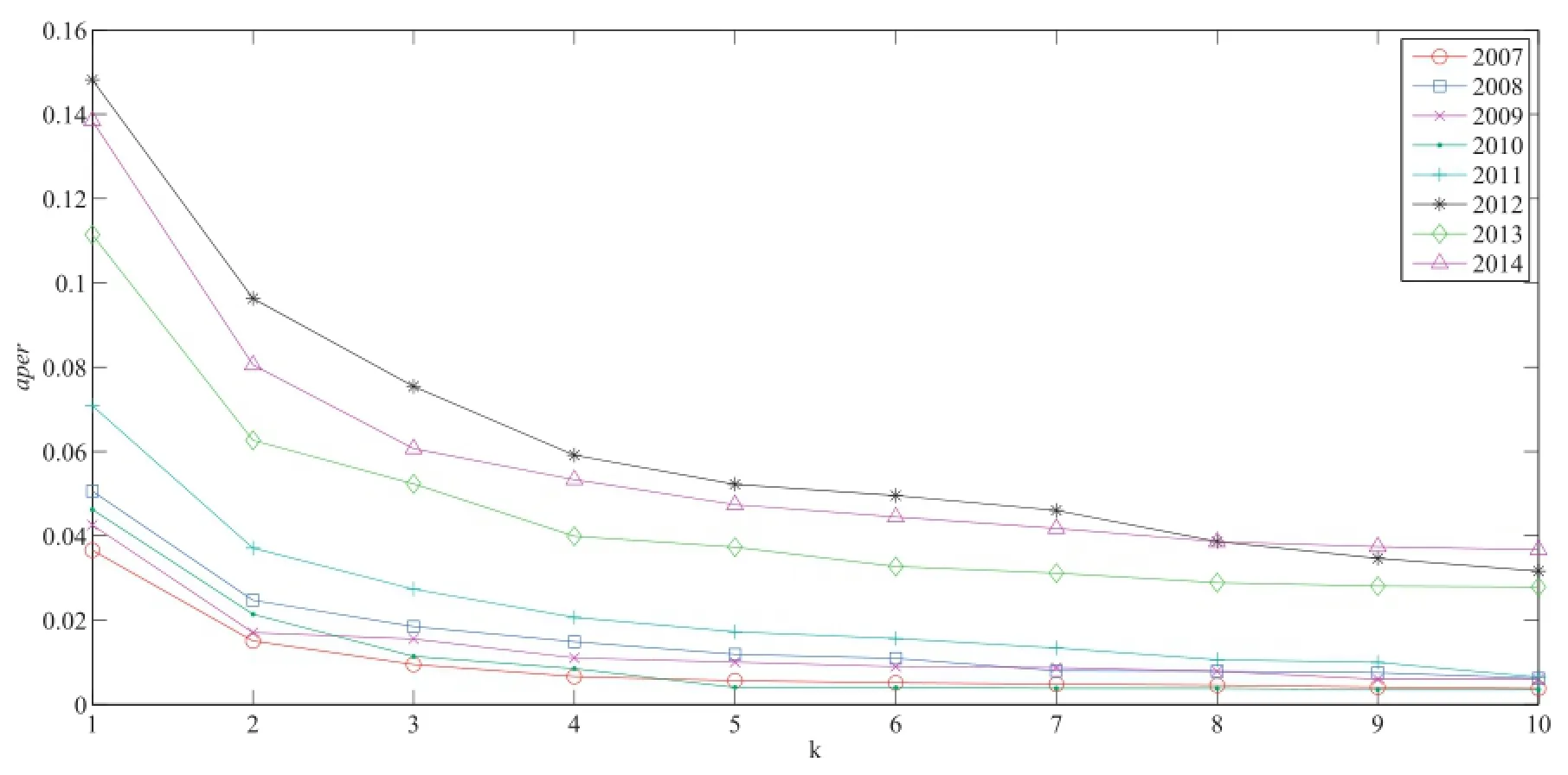
Fig.7.The aper with k in nuclear experiment datasets.
As we know,kis associated with the size of the sub-graph, so that the size of subgraph will increased and the efficiency ofsearch will reduced with the increasing ofk.Fig.8 con firm our analysis.In the nuclear experiment network datasets,the efficiency of searching the shortest path will be weakened with the increase ofk.Taking this into account,we need a smallerkto protect the ef ficiency,i.e.a greateff.In the astro-ph,conmat and hep-th,effwill also deteriorated with the increasing ofk.
We can learn from the above experimental results that the accuracy and ef ficiency are the two objectives to be optimized in the proposed method.Increasingkcan improve the result accuracy but damage the ef ficiency.It is desirable that we need greateffand(1-aper)(smallaperis perfect),but we can't make both great from Fig.9.Then we need a tradeoff of accuracy and efficiency thataperis less than 0.05 in our experiment.
SPCD uses community information to search the SP,so we need an accurate community detection method.We choose two different approaches that BGLL and SHRINK for general network and one that SLPA for the social network.
Fig.10 compares theaperreturned by the three community detection methods.It is observed that SLPA and BGLL performed well while SHRINK can not be used in our method on account of the pooraper.Between SLPA and BGLL,SLPA is better from the network of nucl-ex2010,nucl-ex2012 to nuclex2014.In Fig.11,it obvious that BGLL has the worst eff iciency even though it may be better than SLPA in nucl-ex2012,so the SLPA is the most suitable community detection method for SPCD ofaperandeffconsiders.
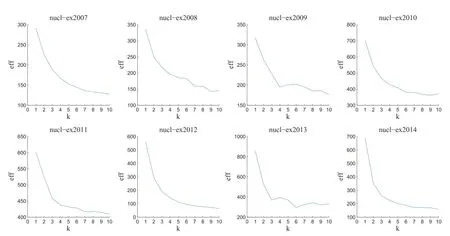
Fig.8.The eff with k in nuclear experiment datasets.

Fig.9.The conflict between aper and eff.

Fig.10.The aper of three communities on nul-ex datasets.
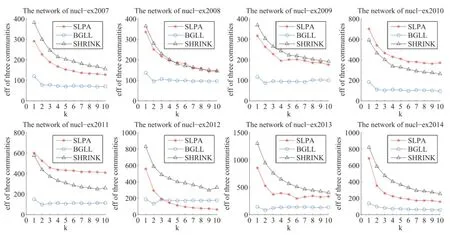
Fig.11.The eff of three communities on nul-ex datasets.
4.Conclusions
In this paper,we proposed a novel and efficient method for P2P shortest path problem on social network.Our method is based on community structure,which could classify the edges into two parts according to cost.Then we construct community graph so as to narrow down the scope of SP and search the SP efficiently.A suitable shortest community path numberkcould guarantee the approximation error.Extensive experimental results on five real-world networks of collaboration networks demonstrated the efficiency and approximation error. For given limit,our algorithm has excellent performance.In particular,various community detection methods could be used in this algorithm.In the future,we will focus on the development of a heuristic method for combining social network community information for SP problem in weighted social networks.Otherwise,it will be interesting to study the community detection algorithm suited to the social network.
[1]J.Scott,P.J.Carrington,The SAGE Handbook of Social Network Analysis,SAGE publications,2011.
[2]J.Xie,B.K.Szymanski,X.Liu,Slpa:Uncovering overlapping communities in social networks via a speaker-listener interaction dynamic process,in:Data Mining Workshops(ICDMW),2011 IEEE 11th International Conference on,IEEE,2011,pp.344-349.
[3]M.E.Newman,Phys.Rev.E 64(1)(2001)016131.
[4]M.Potamias,F.Bonchi,C.Castillo,A.Gionis,Fast shortest path distance estimation in large networks,in:Proceedings of the 18th ACM Conference on Information and Knowledge Management,ACM,2009, pp.867-876.
[5]M.E.Newman,Phys.Rev.E 64(1)(2001)016132.
[6]G.R.Jagadeesh,T.Srikanthan,K.Quek,Intelligent Transp.Syst.IEEE Trans.3(4)(2002)301-309.
[7]S.Jung,S.Pramanik,Knowl.Data Eng.IEEE Trans.14(5)(2002) 1029-1046.
[8]H.A.Karimi,J.Intelligent Transp.Syst.3(2)(1996)111-127.
[9]B.Liu,IEEE Trans.27(4)(1997)436-448.
[10]P.Sanders,D.Schultes,Highway hierarchies hasten exact shortest path queries,in:Algorithms-Esa 2005,Springer,2005,pp.568-579.
[11]L.Fu,D.Sun,L.R.Rilett,Comput.Operations Res.33(11)(2006) 3324-3343.
[12]M.Girvan,M.E.Newman,Proc.Natl.Acad.Sci.99(12)(2002) 7821-7826.
[13]M.E.Newman,Phys.Rev.E 69(6)(2004)066133.
[14]F.Radicchi,C.Castellano,F.Cecconi,V.Loreto,D.Parisi,Proc.Natl. Acad.Sci.U S A 101(9)(2004)2658-2663.
[15]M.E.Newman,M.Girvan,Phys.Rev.E 69(2)(2004)026113.
[16]X.Xu,N.Yuruk,Z.Feng,T.A.Schweiger,Scan:A structural clustering algorithm for networks,in:Proceedings of the 13th ACM SIGKDD International Conference on Knowledge Discovery and Data Mining, ACM,2007,pp.824-833.
[17]Y.-Y.Ahn,J.P.Bagrow,S.Lehmann,Nature 466(7307)(2010)761-764.
[18]V.D.Blondel,J.-L.Guillaume,R.Lambiotte,E.Lefebvre,J.Stat.Mech. Theory Exp.2008(10)(2008)10008.
[19]J.Huang,H.Sun,J.Han,H.Deng,Y.Sun,Y.Liu,Shrink:A structural clustering algorithm for detecting hierarchical communities in networks, in:Proceedings of the 19th ACM International Conference on Information and Knowledge Management,ACM,2010,pp.219-228.
[20]M.-G.Gong,L.-J.Zhang,J.-J.Ma,L.-C.Jiao,J.Comput.Sci.Technol. 27(3)(2012)455-467.
[21]M.Gong,J.Liu,L.Ma,Q.Cai,L.Jiao,Phys.A Stat.Mech.Appl.403 (2014)71-84.
[22]J.Y.Yen,Manag.Sci.17(11)(1971)712-716.
[23]M.E.Newman,Phys.Rev.E 74(3)(2006)036104.
[24]M.E.Newman,Proc.Natl.Acad.Sci.98(2)(2001)404-409.
[25]http://arxiv.org/archive/astro-ph.
[26]http://arxiv.org/archive/cond-mat.
[27]http://arxiv.org/archive/nucl-ex.
[28]E.W.Dijkstra,Numer.Math.1(1)(1959)269-271.
[29]M.L.Fredman,R.E.Tarjan,J.ACM(JACM)34(3)(1987)596-615.
Guide for Authors
Introduction
About the Journal
CAAI Transactions on Intelligence Technologyis an English quarterly journal which is co-founded by the Chinese Association of Artificial Intelligence and Chongqing University of Technology, China, co-published with Elsevier Publishing Company. The journal publishes rigorously peer-reviewed and high quality original articles and authoritative reviews that focus on theoretical, experimental aspects of artificial intelligence technology. Papers describing new artificial intelligence theory closely related to application or have a major impact on development of Intelligence technology are especially welcomed. The original papers should include demonstrations of effectiveness.
Aims and Scopes
The journal will cover but not limited to the following topics:
· machine perception and human interaction
· intelligent information process
· network intelligence and mobile computing
· intelligent control and decision
· robot and intelligent system
CAAI Transactions on Intelligence Technologywill carry brief reports on influential international meetings in the field, as well as an occasional multi-author debate on current topics of interest. Forthcoming meetings of importance will be listed. Special issues devoted to a particular topic will be launched un-regularly.
Editorial Process
All manuscr ipts received are duly acknowledged. Upon submission, the Editorial Office will check the manuscript’s conformity to technical quality and author guidelines, typically within 1 week. Manuscripts with insufficient conformity are returned to authors for revision. Manuscripts with insufficient originality, serious scientific or experimental flaws, or lack of interest to the readership of intelligence technology will be rejected by the Executive Associate Editor without further peer review. Manuscripts deemed suitable for publication are sent to the Editor-in-Chief. The Editor-in-Chief will make initial assessment and will serve as the Associate Editor, who in turn will appoint 2-3 editorial board members and/ or external referees to complete peer reviews within 4 weeks. Based on the recommendations and comments made by peer reviewers, the Associate Editor will make a formal recommendation to the Editors-in-Chief who will make the final decision within 1 week, in consultation with other editorial board members, if deemed necessary. The comments and recommendations (acceptance/ rejection/ minor revision/ major revision in manuscript) received from reviewers are conveyed to the corresponding author. If necessary, the author is required to provide a point by point response to reviewers’comments and submit a revised manuscript. This process will be repeated till reviewers and editors are satisfied with the revised manuscript. Manuscripts accepted for publication are copy edited for grammar, punctuation, print style, and format. Page proofs are sent to the corresponding author. The corresponding author is expected to return the corrected proofs within 48 hours. The whole process of submission of the manuscript, final decision, sending and receiving proofs is completed online. To achieve faster and greater dissemination of knowledge and information, the journal publishes articles online as ‘Ahead of Print’ immediately upon acceptance.
During submission, the contributor is requested to provide names of at least three quali fied reviewers who have had experience in the subject of the submitted manuscript. The reviewers should not be af filiated with the same institutes as the contributor/s. However, the selection of these reviewers is at the sole discretion of the editor.
Contact Details for Submission
For questions on the submission and reviewing process, please contact the Editorial Of fice at: cqznjs@163.com; telephone +86-023-62561406.
Before You Begin
Ethics in Pu blishing
For information on Ethics in Publishing and Ethical guidelines for journal publication see http://www.elsevier.com/publishingethics and http://www.elsevier.com/ethicalguidelines.
Conflict of in terest
All authors are requested to disclose any actual or potential con flict of interest including any financial, personal or other relationships with other people or organizations within three years of beginning the submitted work that could inappropriately in fluence, or be perceived to in fluence, their work. See also http://www.elsevier.com/ con flictso finterest.
Submission decl aration
Submission of an article implies that the work described has not been published previously (except in the form of an abstract or as part of a published lecture or academic thesis), that it is not under consideration for publication elsewhere, that its publication is approved by all authors and tacitly or explicitly by the responsible authorities where the work was carried out, and that, if accepted, it will not be published elsewhere including electronically in the same form, in English or in any other language, without the written consent of the copyright-holder.
Changes to auth orship
This policy concerns the addition, deletion, or rearrangement of author names in the authorship of accepted manuscripts:
Before the accepted manuscript is published in an online issue:Requests to add or remove an author, or to rearrange the author names, must be sent to the Journal Manager from the corresponding author of the accepted manuscript and must include: (a) the reason the name should be added or removed, or the author names rearranged and (b) written con firmation (e-mail, fax, letter) from all authors that they agree with the addition, removal or rearrangement. In the case of addition or removal of authors, this includes con firmation from the author being added or removed. Requests that are not sent by the corresponding author will be forwarded by the Journal Manager to the corresponding author, who must follow the procedure as described above. Note that: (1) Journal Managers will inform the Journal Editors of any such requests and (2) publication of the accepted manuscript in an online issue is suspended until authorship has been agreed.
After the accepted manuscript is published in an online issue:Any requests to add, delete, or rearrange author names in an article published in an online issue will follow the same policies as noted above and result in a corrigendum.
Copyright
Upo n acceptance of an article, authors will be asked to complete a‘Journal Publishing Agreement’. Acceptance of the agreement will ensure the widest possible dissemination of information. An e-mail will be sent to the corresponding author con firming receipt of the manuscript together with a ‘Journal Publishing Agreement’ form or a link to the online version of this agreement.
Permission of the society is required for resale or distribution outside the institution and for all other derivative works, including compilations and translations. If excerpts from other copyrighted works are included, the author(s) must obtain written permission from the copyright owners and credit the source(s) in the article. ]
Role of the fun ding source
You are requested to identify who provided financial support for the conduct of the research and/or preparation of the article and to brie fly describe the role of the sponsor(s), if any, in study design; in the collection, analysis and interpretation of data; in the writing of the report; and in the decision to submit the paper for publication. If the funding source(s) had no such involvement then this should be stated. Please see http://www.elsevier.com/funding.
Language and lan guage services
Please write your text in good English (American or British usage is accepted, but not a mixture of these). Authors who require information about language editing and copyediting services preand post-submission please visit http://webshop.elsevier.com/ languageediting or our customer support site at http://support. elsevier.com for more information.
Submission
Sub mission to this journal proceeds totally online and you will be guided stepwise through the creation and uploading of the various files. The system automatically converts source files to a single Adobe Acrobat PDF version of the article, which is used in the peerreview process. Please note that even though manuscript source files are converted to PDF at submission for the review process, these source files are needed for further processing after acceptance. All correspondence, including noti fication of the Editor’s decision and requests for revision, takes place by e-mail and via the author’s homepage, removing the need for a hard-copy paper trail. If you are unable to provide an electronic version, please contact the editorial of fice prior to submission.
Additional Infor mation
Tables and figures may be presented with captions within the main body of the manuscript; if so, figures should additionally be uploaded as high resolution files.
Preparation
Use of word pr oce ssing software
It is important that the file be saved in the native format of the word processor used. The text should be in single-column format. Keep the layout of the text as simple as possible. Most formatting codes will be removed and replaced on processing the article. In particular, do not use the word processor’s options to justify text or to hyphenate words. However, do use bold face, italics, subscripts, superscripts etc. When preparing tables, if you are using a table grid, use only one grid for each individual table and not a grid for each row. If no grid is used, use tabs, not spaces, to align columns. The electronic text should be prepared in a way very similar to that of conventional manuscripts (see also the Guide to Publishing with Elsevier: http://www.elsevier. com/guidepublication). Note that source files of figures, tables and text graphics will be required whether or not you embed your figures in the text. See also the section on Electronic illustrations.
To avoid unnecessary errors you are strongly advised to use the“spell-check” and “grammar-check” functions of your wordprocessor.
LaTeX
If the LaT eX file is suitable, proofs will be produced without rekeying the text. The article should preferably be written using Elsevier’s document class “elsarticle”, or alternatively any of the other recognized classes and formats supported in Elsevier’s electronic submissions system, for further information see http://www.elsevier. com/wps/find/authorsview.authors/latex-ees-supported.
The Elsevier “elsarticle” LaTeX style file package (including detailed instructions for LaTeX preparation) can be obtained from the Quickguide: http://www.elsevier.com/latex. It consists of the file: elsarticle.cls, complete user documentation for the class file, bibliographic style files in various styles, and template files for a quick start.
Article structure
Subdivision - number ed sections
Divide your article into clearly defined and numbered sections. Subsections should be numbered 1.1 (then 1.1.1, 1.1.2, ...), 1.2, etc. (the abstract is not included in section numbering). Use this numbering also for internal cross-referencing: do not just refer to “the text”. Any subsection may be given a brief heading. Each heading should appear on its own separate line.
Introduction
State the objectives of the work and provide an adequate background, avoiding a detailed literature survey or a summary of the results.
Material and methods
Provide sufficient detail to allow the work to be reproduced. Methods already published should be indicated by a reference: only relevant modifications should be described.
Theory/calculation
A Theory section should extend, not repeat, the background to the article already dealt with in the Introduction and lay the foundation for further work. In contrast, a Calculation section represents a practical development from a theoretical basis.
Results
Results sho uld be clear and concise.
Discussion
This sho uld explore the significance of the results of the work, not repeat them. A combined Results and Discussion section is often appropriate. Avoid extensive citations and discussion of published literature.
Conclusions
The mai n conclusions of the study may be presented in a short Conclusions section, which may stand alone or form a subsection of a Discussion or Results and Discussion section.
Appendices
If there is more than one appendix, they should be identified as A, B, etc. Formulae and equations in appendices should be given separate numbering: Eq. (A.1), Eq. (A.2), etc.; in a subsequent appendix, Eq. (B.1) and so on. Similarly for tables and figures: Table A.1; Fig. A.1, etc.
Essential title page information
· Title.Concise and informative. Titles are often used in informationretrieval systems. Avoid abbreviations and formulae where possible.· Author namesand affiliations. Where the family name may be ambiguous (e.g., a double name), please indicate this clearly. Present the authors’ affiliation addresses (where the actual work was done) below the names. Indicate all affiliations with a lower-case superscript letter immediately after the author’s name and in front of the appropriate address. Provide the full postal address of each affiliation, including the country name, and, if available, the e-mail address of each author.
· Corresponding author. Clearly indicate who will handle correspondence at all stages of refereeing and publication, also postpublication. Ensure that telephone and fax numbers (with country and area code) are provided in addition to the e-mail address and the complete postal address. Contact details must be kept up to date by the corresponding author.
· Present/permanent address.If an author has moved since the work described in the article was done, or was visiting at the time, a “Present address” (or “Permanent address”) may be indicated as a footnote to that author’s name. The address at which the author actually did the work must be retained as the main, affiliation address. Superscript Arabic numerals are used for such footnotes.
Abstract
A concise and factual abstract is required. The abstract should state briefly the purpose of the research, the principal results and major conclusions. An abstract is often presented separately from the article, so it must be able to stand alone. For this reason, References should be avoided, but if essential, then cite the author(s) and year(s). Also, non-standard or uncommon abbreviations should be avoided, but if essential they must be defined at their first mention in the abstract itself.
Keywords
Authors a re invited to submit keywords associated with their paper.
Abbreviations
Define abbreviations that are not standard in this field in a footnote to be placed on the first page of the article. Such abbreviations that are unavoidable in the abstract must be defined at their first mention there, as well as in the footnote. Ensure consistency of abbreviations throughout the article.
Acknowledgements
C ollate acknowledgements in a separate section at the end of the article before the references and do not, therefore, include them on the title page, as a footnote to the title or otherwise. List here those individuals who provided help during the research (e.g., providing language help, writing assistance or proof reading the article, etc.).
Nomenclature and uni ts
Follow internationally accepted rules and conventions: use the international system of units (SI). If other quantities are mentioned, give their equivalent in SI. Authors wishing to present a table of nomenclature should do so on the second page of their manuscript.
Math formulae
Pres ent simple formulae in the line of normal text where possible and use the solidus (/) instead of a horizontal line for small fractional terms, e.g., X/Y. In principle, variables are to be presented in italics. Powers of e are often more conveniently denoted by exp. Number consecutively any equations that have to be displayed separately from the text (if referred to explicitly in the text).
Footnotes
Footnote s should be used sparingly. Number them consecutively throughout the article, using superscript Arabic numbers. Many wordprocessors build footnotes into the text, and this feature may be used. Should this not be the case, indicate the position of footnotes in the text and present the footnotes themselves separately at the end of the article. Do not include footnotes in the Reference list.
Table footnotes
Indicate each footnote in a table with a superscript lowercase letter.
Artwork
Electronic artwork
General points
· Make sure you use uniform lettering and sizing of your original artwork.
· Save text in illustrations as “graphics” or enclose the font.
· Only use the following fonts in your illustrations: Arial, Courier, Times, Symbol.
· Number the illustrations according to their sequence in the text.
· Use a logical naming convention for your artwork files.
· Provide captions to illustrations separately.
· Produce images near to the desired size of the printed version.
· Submit each figure as a separate file.
A detailed guide on electronic artwork is available on our website:
http://www.elsevier.com/artworkinstructions
You are urged to visit this site; some excerpts from the detailed information are given here.
Formats
Regardless of the application used, when your electronic artwork is finalised, please “save as” or convert the images to one of the following formats (note the resolution requirements for line drawings, halftones, and line/halftone combinations given below):
EPS: Vector drawings. Embed the font or save the text as “graphics”. TIFF: color or grayscale photographs (halftones): always use a minimum of 300 dpi.
TIFF: Bitmapped line drawings: use a minimum of 1000 dpi.
TIFF: Combinations bitmapped line/half-tone (color or grayscale): a minimum of 500 dpi is required.
If your electronic artwork is created in a Microsoft Office application (Word, PowerPoint, Excel) then please supply “as is”.
Please do not:
· Supply files that are optimized for screen use (like GIF, BMP, PICT, WPG); the resolution is too low;
· Supply files that are too low in resolution;
· Submit graphics that are disproportionately large for the content.
Color artwork
Please make sure that artwork files are in an acceptable format (TIFF, EPS or MS Office files) and with the correct resolution. If, together with your accepted article, you submit usable color figures then Elsevier will ensure, at no additional charge, that these figures will appear in color on the Web (e.g., ScienceDirect and other sites) regardless of whether or not these illustrations are reproduced in color in the printed version.
Figure captions
Ensu re that each illustration has a caption. Supply captions separately, not attached to the figure. A caption should comprise a brief title (noton the figure itself) and a description of the illustration. Keep text in the illustrations themselves to a minimum but explain all symbols and abbreviations used.
Tables
Number table s consecutively in accordance with their appearance in the text. Place footnotes to tables below the table body and indicate them with superscript lowercase letters. Avoid vertical rules. Be sparing in the use of tables and ensure that the data presented in tables do not duplicate results described elsewhere in the article.
References
Ple ase ensure that every reference cited in the text is also present in the reference list (and vice versa). Any references cited in the abstract must be given in full. Unpublished results and personal communications are not recommended in the reference list, but may be mentioned in the text. If these references are included in the reference list they should follow the standard reference style of the journal and should include a substitution of the publication date with either “Unpublished results” or “Personal communication” Citation of a reference as “in press” implies that the item has been accepted for publication.
Web references
As a minimum, the full URL should be given and the date when the reference was last accessed. Any further information, if known (DOI, author names, dates, reference to a source publication, etc.), should also be given. Web references can be listed separately (e.g., after the reference list) under a different heading if desired, or can be included in the reference list.
References in a speci al issue
Please ensure that the words ‘this issue’ are added to any references in the list (and any citations in the text) to other articles in the same Special Issue.
Reference management software
This journal has standard templates available in key reference management packages EndNote ( http://www.endnote.com/support/ enstyles.asp) and Reference Manager ( http://refman.com/support/ rmstyles.asp). Using plug-ins to word processing packages, authors only need to select the appropriate journal template when preparing their article and the list of references and citations to these will be formatted according to the journal style which is described below.
Reference style
Text: Indicate references by number(s) in square brackets in line with the text. The actual authors can be referred to, but the reference number(s) must always be given.
Example: “..... as emonstrated *3,6+. Barnaby and Jones *8+ obtained a different result ....”
List: Number the references (numbers in square brackets) in the list in the order in which they appear in the text.
Examples:
Reference to a journal publication:
[1] J. van der Geer, J.A.J. Hanraads, R.A. Lupton, J. Sci. Commun. 163 (2000) 51—59.
Reference to a book:
[2] W. Strunk Jr., E.B. White, The Elements of Style, third ed., Macmillan, New York, 1979.
Reference to a chapter in an edited book:
[3] G.R. Mettam, L.B. Adams, in: B.S. Jones, R.Z. Smith (Eds.), Introduction to the Electronic Age, E-Publishing, Inc., New York, 1994, pp. 281—304.
Journal abbreviations source
Journal names should be abbreviated according to List of title word abbreviations: http://www.issn.org/2-22661-LTWA-online.php;
S ubmission checklist
The following list will be useful during the final checking of an article prior to sending it to the journal for review. Please consult this Guide for Authors for further details of any item.
Ensure that the following items are present:
One Author designated as corresponding Author:
· E-mail address
· Full postal address
· Telephone and fax numbers
All necessary files have been uploaded
· Keywords
· All figure captions
· All tables (including title, description, footnotes)
Further considerations
· Manuscript has been “spellchecked” and “grammar-checked”
· References are in the correct format for this journal
· All references mentioned in the Reference list are cited in the text, and vice versa
· Permission has been obtained for use of copyrighted material from other sources (including the Web)
· Color figures are clearly marked as being intended for color reproduction on the Web (free of charge) and in print or to be reproduced in color on the Web (free of charge) and in black-andwhite in print
· If only color on the Web is required, black and white versions of the figures are also supplied for printing purposes
For any further information please visit our customer support site at http://support.elsevier.com.
After Acceptance
Us e of the Digital Object Identifier
The Digital Object Identi fier (DOI) may be used to cite and link to electronic documents. The DOI consists of a unique alpha-numeric character string which is assigned to a document by the publisher upon the initial electronic publication. The assigned DOI never changes. Therefore, it is an ideal medium for citing a document, particularly ‘Articles in press’ because they have not yet received their full bibliographic information. The correct format for citing a DOI is shown as follows (example taken from a document in the journal Physics Letters B): doi:10.1016/j.physletb.2010.09.059
When you use the DOI to create URL hyperlinks to documents on the web, they are guaranteed never to change.
Pr oofs
One set of page proofs (as PDF files) will be sent by e-mail to the corresponding author (if we do not have an e-mail address then paper proofs will be sent by post) or, a link will be provided in the e-mail so that authors can download the files themselves. Elsevier now provides authors with PDF proofs which can be annotated; for this you will need to download Adobe Reader version 7 (or higher) available free from http://get.adobe.com/reader. Instructions on how to annotate PDF files will accompany the proofs (also given online). The exact system requirements are given at the Adobe site: http:// www.adobe.com/products/reader/systemreqs.
If you do not wish to use the PDF annotations function, you may list the corrections (including replies to the Query Form) and return them to Elsevier in an e-mail. Please list your corrections quoting line number. If, for any reason, this is not possible, then mark the corrections and any other comments (including replies to the Query Form) on a printout of your proof and return by fax, or scan the pages and e-mail, or by post. Please use this proof only for checkingthe typesetting, editing, completeness and correctness of the text, tables and figures. Significant changes to the article as accepted for publication will only be considered at this stage with permission from the Editor. We will do everything possible to get your article published quickly and accurately — please let us have all your corrections within 48 hours. It is important to ensure that all corrections are sent back to us in one communication: please check carefully before replying, as inclusion of any subsequent corrections cannot be guaranteed. Proofreading is solely your responsibility. Note that Elsevier may proceed with the publication of your article if no response is received.
Offp rints
The corresponding author, at no cost, will be provided with a PDF file of the article via e-mail. For an extra charge, paper off prints can be ordered via the offprint order form which is sent once the article is accepted for publication. The PDF file is a watermarked version of the published article and includes a cover sheet with the journal cover image and a disclaimer outlining the terms and conditions of use.
More information about article offprint is available here: http:// webshop.elsevier.com/
Author Inquiries
Fo r inquiries relating to the submission of articles (including electronic submission) please visit this journal’s homepage. Contact details for questions arising after acceptance of an article, especially those relating to proofs, will be provided by the publisher. You can track accepted articles at http://www.elsevier.com/trackarticle. You can also check our Author FAQs ( http://www.elsevier.com/ authorFAQ) and/or contact Customer Support via http://support. elsevier.com.
in text
Available online 2 June 2016
☆This work was supported in part by the National Natural Science Foundation of China under Grants 61273317,and 61422209,the National Program for Support of Top-notch Young Professionals of China,and the Specialized Research Fund for the Doctoral Program of Higher Education under Grant 20130203110011.
*Corresponding author.
E-mail address:gong@ieee.org(M.Gong).
Peer review under responsibility of Chongqing University of Technology.
http://dx.doi.org/10.1016/j.trit.2016.03.011
2468-2322/Copyright©2016,Chongqing University of Technology.Production and hosting by Elsevier B.V.This is an open access article under the CC BY-NCND license(http://creativecommons.org/licenses/by-nc-nd/4.0/).
Copyright©2016,Chongqing University of Technology.Production and hosting by Elsevier B.V.This is an open access article under the CC BY-NC-ND license(http://creativecommons.org/licenses/by-nc-nd/4.0/).
杂志排行
CAAI Transactions on Intelligence Technology的其它文章
- Multi-LeapMotion sensor based demonstration for robotic refine tabletop object manipulation task☆
- A framework for multi-session RGBD SLAM in low dynamic workspace environment
- RPK-table based efficient algorithm for join-aggregate query on MapReduce
- Frame interpolation with pixel-level motion vector field and mesh based hole filling
- Exploiting structural similarity of log files in fault diagnosis for Web service composition
- Background modeling methods in video analysis:A review and comparative evaluation
